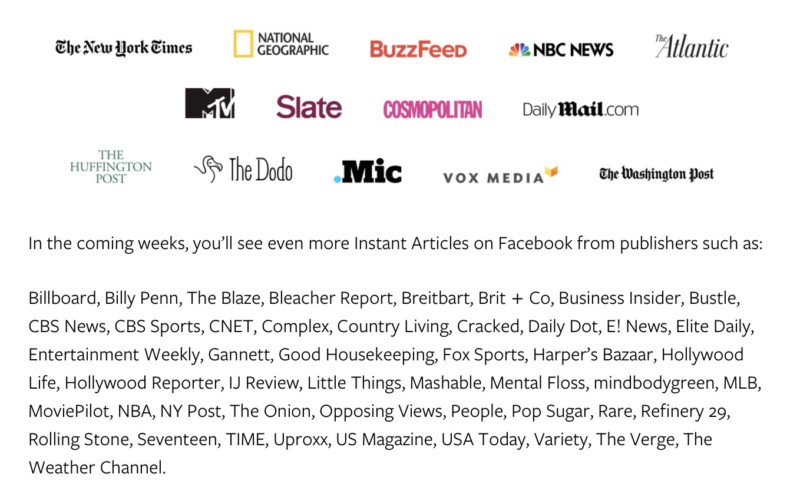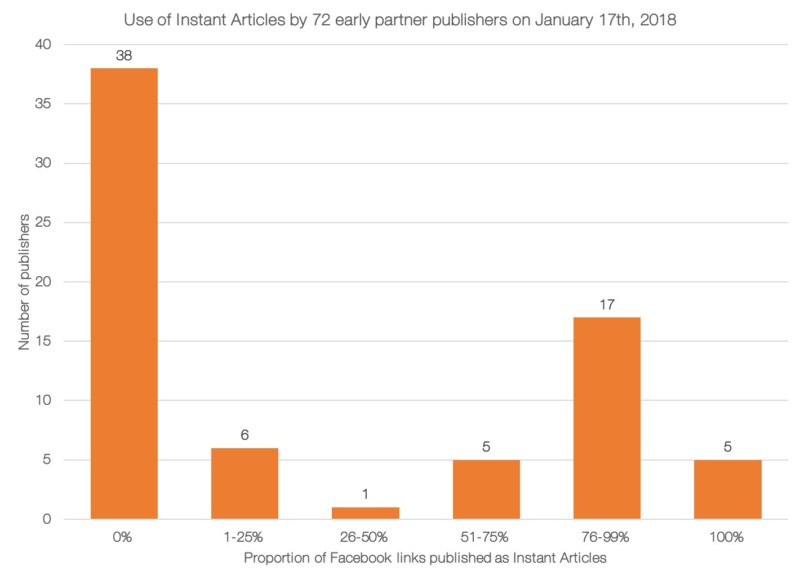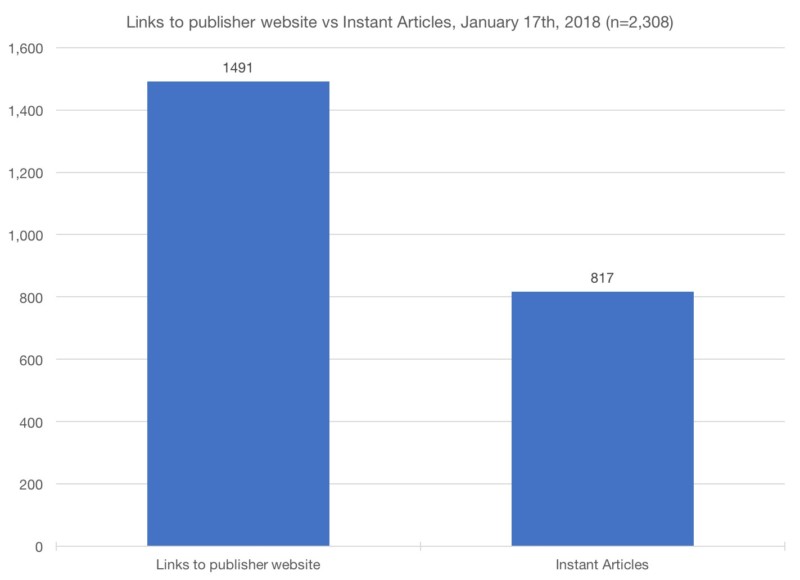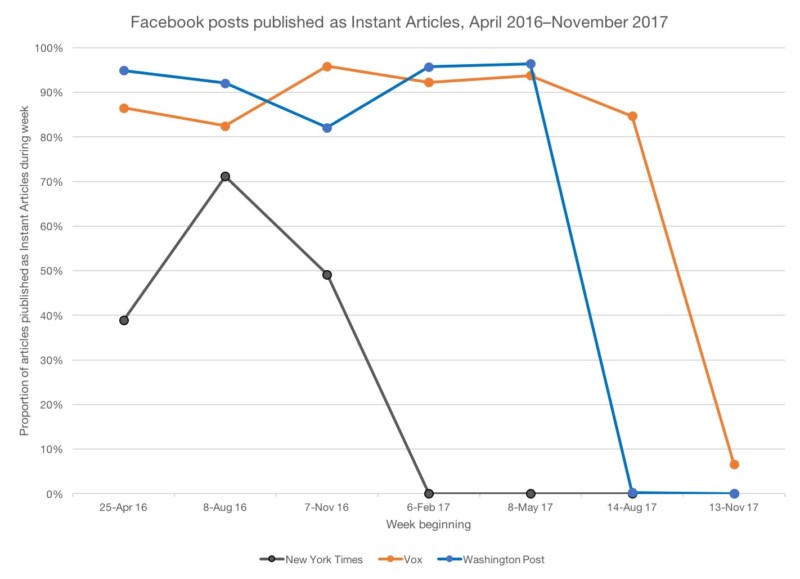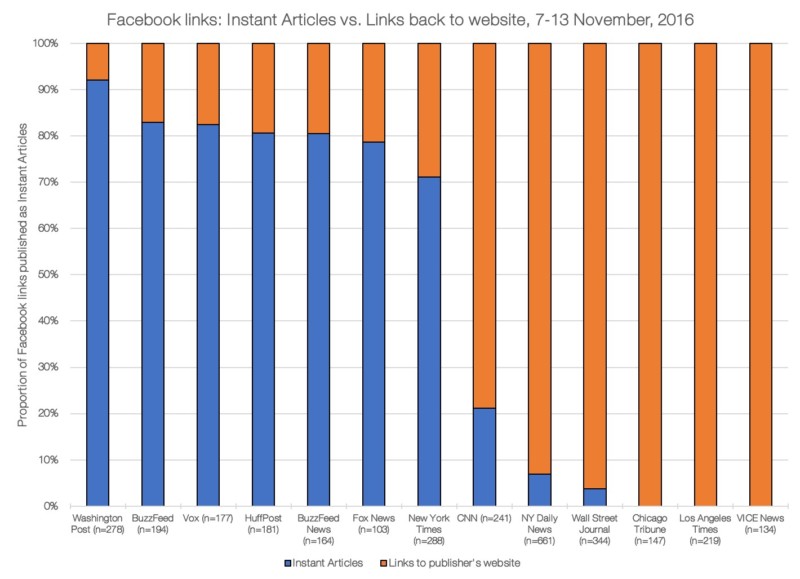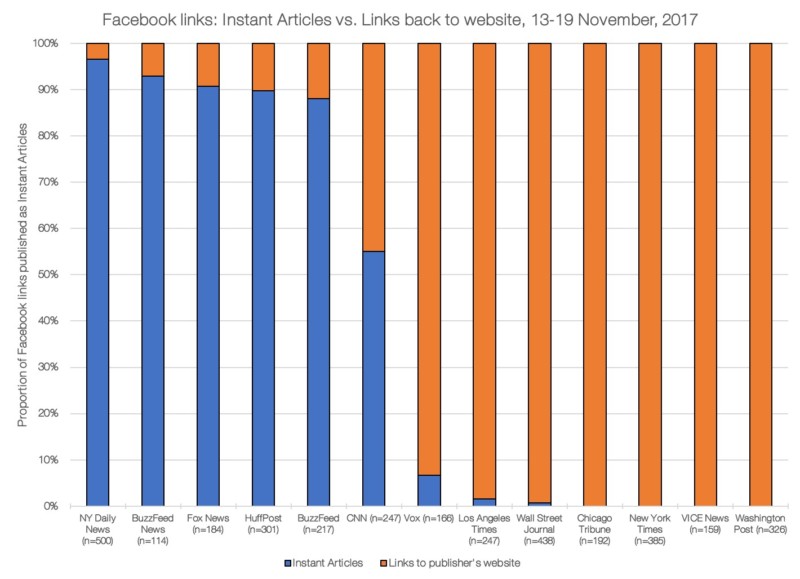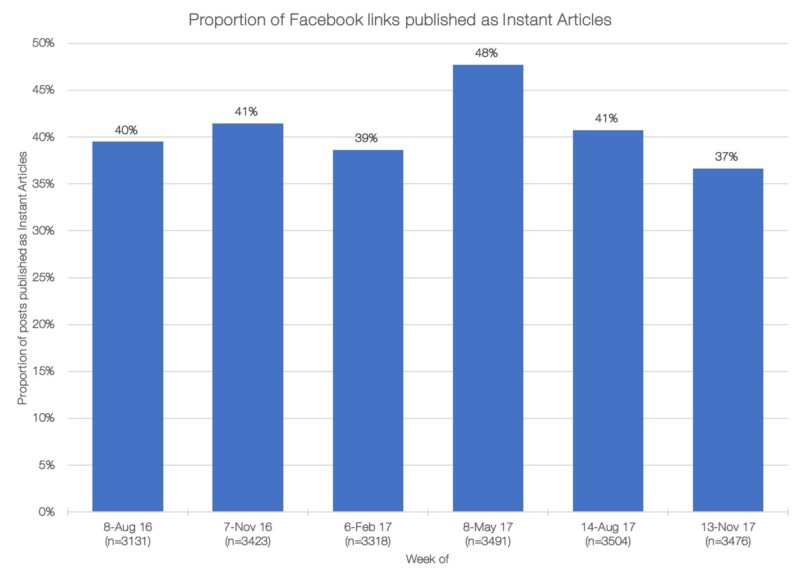Sign up for the daily CJR newsletter.
More than half of Facebook’s launch partners on Instant Articles appear to have abandoned the format, new Tow Center research suggests.
Of 72 publishers that Facebook identified as original partners in May and October 2015, our analysis of 2,308 links posted to their Facebook pages on January 17, 2018, finds that 38 publications did not post a single Instant Article—the platform’s fast-loading, native format. In the meantime, Facebook has continued to tout Instant Articles as a success among its journalism efforts. Instant Articles enjoyed rapid expansion in 2017, it says. But if many of the largest reputable outlets are falling out, which publications are driving that growth?
ICYMI: Former New York Times journalists are furious
When launching Instant Articles in May 2015, Facebook presented its new initiative as a commitment to helping publishers monetize journalism distributed via its platform.
Instant Articles, it was claimed, would solve the problem of sluggish mobile websites. While publishers would have to host their articles on Facebook’s servers and post natively to the platform, they would supposedly reap rewards—in terms of scale, engagement, and revenue—from being able to serve mobile content that loaded at lightning speeds via Facebook’s app.
The New York Times, an initial partner, reported that Facebook went “to unusual lengths to court the publishers participating in the project.” Viewed in the wake of the recent, seismic algorithm change, this publisher-friendly approach feels like a relic from a bygone age.
An introductory post by Michael Reckhow, then-product manager for Instant Articles, framed the product as a way for news outlets to regain control of news production and dissemination—something that critics argued they had ceded to third-party, social media platforms.
UPDATE: Texas Monthly releases statement after our report on its cover story controversy
Reckhow wrote: “We designed Instant Articles to give publishers control over their stories, brand experience, and monetization opportunities. Publishers can sell ads in their articles and keep the revenue, or they can choose to use Facebook’s Audience Network to monetize unsold inventory. Publishers will also have the ability to track data and traffic through comScore and other analytics tools.”
Over half of Facebook’s launch partners for Instant Articles did not use the format in early 2018.
When Instant Articles launched over two and a half years ago, some publishers went all in at the earliest opportunity. The Washington Post, for example, embraced the product with much fanfare in September 2015, stating that it would “send 100 percent of its stories to Facebook so that all Washington Post content can be formatted as Instant Articles, giving readers a lightning-fast user experience for reading, sharing and commenting within the Facebook iOS app.” The Post’s publisher, Fred Ryan, further justified the move, adding, “We want to reach current and future readers on all platforms, and we aren’t holding anything back.” (Other early partners only committed to posting five Instant Articles at launch.)
Fast-forward to 2018 and The Washington Post is just one of a number of early partners that appears to have shelved Instant Articles.
Note on methodology: To get a current snapshot of Instant Articles usage among Facebook’s launch partners, we analyzed 2,391 links posted to their Facebook pages on January 17, 2018 (12am–11:59pm ET). (For the purpose of this analysis, Marie Claire was included to represent Hearst and Sports Illustrated was selected for Time, Inc.) We removed 83 posts that explicitly stated they had been shared from another brand’s page. This left an overall sample of 2,308 links. Each of these was then coded according to whether or not it had been formatted as an Instant Article.
Below is an extract from the Facebook Media page announcing new partners for Instant Articles. (Source: Facebook.)
Overall, 38 of the 72 pages—54 percent of the sample of publishers—did not post a single Instant Article. In other words, over half of Facebook’s launch partners for Instant Articles did not use the format. A further six publishers formatted fewer than a quarter of their links as Instant Articles.
The 38 outlets that did not post a single Instant Article to Facebook were: Billboard, Brit + Co, CBS News, CBS Sports, Cosmopolitan, Country Living, Curbed, E! News, Eater, Entertainment Weekly, Fox Sports, Good Housekeeping, The Guardian, Harper’s Bazaar, Hollywood Life, The Hollywood Reporter, Marie Claire, moviepilot.com, National Geographic, NBA.com, NBC News, The New York Times, The Onion, People, Polygon, Racked, Recode, Refinery29, Rolling Stone, SB Nation, Seventeen, UPROXX, Us Weekly, Variety, The Verge, Vox, The Washington Post, and The Weather Channel.
Scanning through the list, it’s worth pointing out that not only does it contain legacy publishers and subscription-based outlets such as The New York Times (whose business models were never a good fit with the paywall-free nature of Instant Articles), it also shows that digital natives have walked away from Instant Articles as well.
The decision to shun Instant Articles means that considerably more links direct traffic back to publishers’ websites than remain native to Facebook.
Of the 2,308 links analyzed, 1,491 (around two-thirds) went to a publisher’s homepage, leaving 817 as Instant Articles.
What does this say about Instant Articles?
Instant Articles has been criticized for underwhelming monetization, limited user data, and underwhelming options for subscription-based outlets. However, even with our new data, it is tricky to argue that Instant Articles is a failing product because Facebook can still point to growth and big numbers. Last June, the company boasted that it had “10,000 publishers around the world using Instant Articles, growing over 25 percent in the last six months alone.”
But, with the high-profile publishers moving out of Instant, is this another example of Facebook prioritizing quantity over quality?
ICYMI: Why newsrooms are using mobile push alerts for brand, not breaking
On the first anniversary of Instant Articles, Facebook’s Will Cathcart told The Verge, “People come to Facebook for news, and they want to read it…. We deeply believe that the only way to have publishers use Instant Articles is if this works for them.”
With an algorithm change deliberately designed to surface less news and data suggesting that Instant Articles “doesn’t work” for a majority of its launch partners, the next obvious question is: Who does it work for?
The reported growth in Instant Articles could be driven by an uptick in use by local publishers, specialist publications, or amateur outfits. It’s difficult to tell—and Facebook’s announcement doesn’t say.
Above: Declining use of Instant Articles by The New York Times, Vox, and The Washington Post, April 2016–November 2017.
Tracking Instant Articles over time
Since April 2016, the Tow Center’s Platforms and Publishers content study has tracked a sample of 14 publishers’ usage of Instant Articles. During this period, we have seen our fair share of comings and goings. We have not seen enthusiastic adoption of the format; nor have we seen wide-scale abandonment. However, we did track more outs than ins: a stubborn lack of growth, and a downward trajectory in usage.
During the first year of our analysis, in 2016, use of Instant Articles followed a familiar pattern:
- The digital natives (BuzzFeed, BuzzFeed News, HuffPost, and Vox) remained all in, as did The Washington Post and Fox News;
- Usage by The New York Times and CNN fluctuated;
- The New York Daily News posted a tiny proportion of articles in Facebook’s native format, as did the subscription-based Wall Street Journal;
- The subscription-based Tronc titles (the Chicago Tribune and Los Angeles Times) completely shunned the format, as did Vice, reflecting its CEO’s antipathy to Facebook’s attempts to control the distribution of journalism.
Fast-forward 12 months and even among this relatively small group of publishers some notable shifts had occured. Of our sample, only BuzzFeed, BuzzFeed News, and HuffPost had remained staunchly committed to Instant Articles. Fox News left, but then returned. CNN remained noncommittal, typically posting 40–60 percent of stories as Instant Articles. The Wall Street Journal, Vice News, and the Tronc titles have steered clear. This period also covers the aforementioned departures by The New York Times, The Washington Post, and Vox.
The only outlet in our sample to have gone in the other direction is the New York Daily News, whose embrace of Instant Articles we first observed in May 2017.
Indeed, in terms of the number and proportion of articles being published as Instant Articles, departures by The New York Times and The Washington Post have been offset to some extent by the steadfastness of the Daily News, a prolific Facebook poster (it made 526 posts in the week beginning on November 13, 2017).
ICYMI: Jonah Peretti: Everything is fine
From August 2016 to November 2017, the overall proportion of posts published as Instant Articles by the publishers in our study hasn’t grown, typically hovering around 40 percent.
This further indicates that Facebook has struggled to persuade bigger publishers of the merits of Instant Articles. Of those in our sample, more have either abandoned or significantly scaled back their usage. What’s more, the proportion of posts published as Instant Articles has followed a downward trajectory in the two most recent analyses, falling to an all-time low of 37 percent in November 2017, our most recent snapshot.
With the news that Facebook has de-prioritized brand pages with its algorithm change, there is arguably less incentive than ever for publishers to embrace Instant Articles.
ICYMI: The story BuzzFeed, The New York Times and more didn’t want to publish
Has America ever needed a media defender more than now? Help us by joining CJR today.




